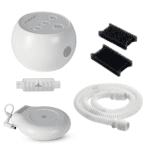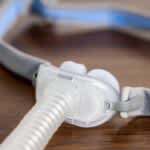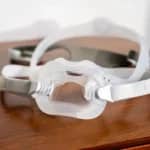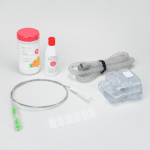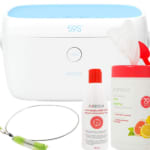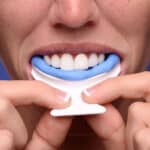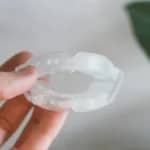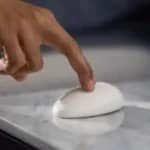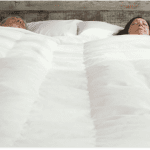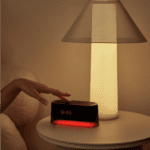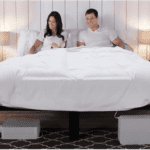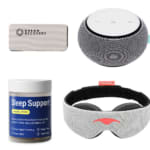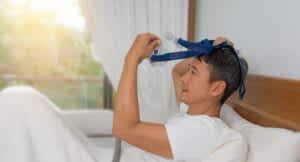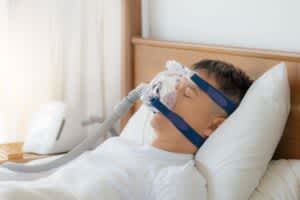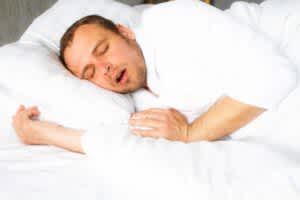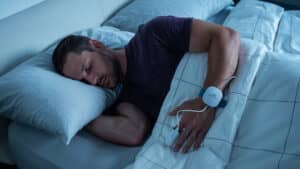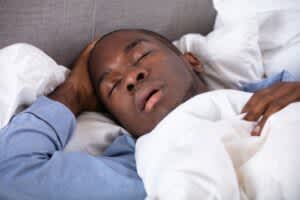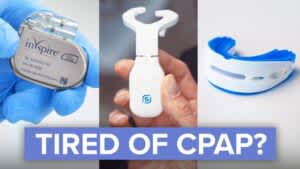A hypopnea is a decrease in airflow during sleep. People with obstructive sleep apnea or central sleep apnea commonly experience a large number of hypopneas at night.
Experiencing too many hypopnea events can lead to health issues, fragmented sleep, and sleep loss. Since hypopneas occur during sleep, people may struggle to recognize the symptoms. Learning more about hypopneas and how they impact health may help you recognize the signs of sleep apnea and get help if needed.
Hypopnea Definition
According to the American Academy of Sleep Medicine, a hypopnea is a period of shallow breathing during sleep identified by three criteria:
- Airflow rate dropping by 30% or more
- Reduced airflow continuing for 10 seconds or more
- Blood oxygen level dropping by more than 3% or 4%
The criteria to define a hypopnea event has changed over time, and there may still be variation between sleep centers in how they define a hypopnea.
How Is Hypopnea Different from Sleep Apnea?
“Sleep apnea” is a general term often used to refer to sleep-related breathing disorders and includes two types: obstructive sleep apnea (OSA) and central sleep apnea (CSA).
The term “apnea” can also refer to an abnormal breathing pattern that occurs during sleep. An apnea is a pause in breathing during sleep, whereas a hypopnea is a reduction in airflow.
People who have sleep apnea experience an excessive number of apneas and hypopneas during sleep. In OSA, the apneas and hypopneas result from a physically blocked airway. In CSA, apneas and hypopneas occur due to a disruption in the signal between the brain and the muscles that help with breathing.
Both apneas and hypopneas typically last longer and worsen during rapid eye movement (REM) sleep, a stage of sleep known for dreaming. Both types of disordered breathing events can keep a person from getting adequate oxygen. According to experts, hypopnea and apnea events share similar symptoms and health effects.
Types of Hypopneas
A person can have more than one type of hypopnea.
- Obstructive hypopneas: Obstructive hypopneas occur when the upper airway narrows or collapses during sleep.
- Central hypopneas: Central hypopneas arise when the brain temporarily stops signaling the muscles to breathe.
- Mixed hypopneas: This type of hypopnea shares characteristics of both obstructive and central hypopneas.
Symptoms of Hypopneas
Hypopneas are hard to recognize and diagnose because they occur during sleep, when a person lacks awareness. They are also more subtle than apneas. Oftentimes, symptoms like snoring and coughing are only noticed by family members and bed partners.
Symptoms of sleep disorders that involve excessive hypopneas include:
- Loud snoring
- Excessive daytime sleepiness
- Waking up at night
- Gasping during sleep
- Choking or coughing during sleep
- Headaches in the morning
What Causes Hypopneas?
Hypopneas generally result from one of two causes.
- Narrowed airways: Physical features, like a large tongue or short neck, can narrow the upper airway. This narrowed airway makes breathing difficulties during sleep, like hypopnea, more likely.
- Brain signal malfunction: Increased hypopneas may occur when the brain cannot send the right signals to control breathing and chest muscles during sleep.
Hypopnea Risk Factors
Hypopneas are symptoms of the sleep disorders obstructive sleep apnea (OSA) and central sleep apnea (CSA). There are a number of factors that increase risk for developing hypopneas and sleep apnea.
- Obesity: About 60% of people who have moderate or severe OSA are thought to have developed it as the result of excess body weight, which puts pressure on the airway and causes it to narrow more easily.
- Neck size: In people with a higher body mass index, neck size increases the risk of developing OSA.
- Menopause: Menopause, the end of menstruation, causes an increased risk of developing OSA. Menopausal hormone therapy may help.
- Smoking: More research is needed, but smoking cigarettes may make a person more likely to have OSA.
- Facial anatomy: Abnormalities in the face, head, neck, jaw, or throat could create a narrowed upper airway that causes OSA symptoms during sleep.
- Medical disorders: Certain disorders, like thyroid problems, Down syndrome, and some neurological issues are associated with developing OSA.
- Sedatives: Taking sedative medications or consuming alcohol can make symptoms of OSA more severe.
- Nasal congestion: A person may experience increased OSA symptoms while having congestion, such as from allergies, because it can constrict the airway.
The risk factors for CSA overlap with OSA but also include having congestive heart failure or stroke. In people who have experienced heart failure, those who are male or more than 60 years old are even more likely to develop CSA and have increased hypopneas.
Snoring? An At-Home Sleep Test May Be the Answer

Save 54% on your Sleep Test Today
Simple and convenient
- Equipment delivered to your doorstep
- One overnight test in the comfort of your own bed
Uncover sleep apnea
- Quietly collects data while you sleep
- 98% effective in detecting sleep apnea
Affordable & ships fast
- In-lab sleep tests cost ~$3,000+ (this one’s $189), HSA/FSA eligible
- Arrives in 2-4 business days
How Are Hypopneas Diagnosed?
Since hypopneas are symptoms, rather than a disorder, they are measured during diagnostic testing for sleep apnea. People who have a large number of hypopneas are diagnosed with obstructive or central sleep apnea.
The standard for diagnosing sleep apnea is a simple home sleep test or a sleep study in a lab, also called polysomnography. A sleep study records multiple physical markers as a person sleeps, including airflow and blood oxygen levels. Sleep studies are conducted overnight in a sleep clinic, but for some people, a modified version can be performed at home.
Sleep specialists use the apnea-hypopnea index (AHI) to identify and measure the severity of apnea and hypopnea episodes during sleep. To calculate an AHI, the number of apneas and hypopneas are added up then divided by the total hours of sleep.
An obstructive sleep apnea diagnosis requires an obstructive AHI of 15 or more, while a central sleep apnea diagnosis requires a central AHI of 5 or more. These numbers indicate the average number of apneas and hypopneas a person experienced per hour as they slept.
Sometimes, sleep specialists also report the average number of hypopneas experienced per hour directly. This is called the hypopnea index.
Treatment Options
A number of treatments to reduce hypopneas are available. The type of treatment a doctor recommends will depend on whether a person has obstructive sleep apnea (OSA) or central sleep apnea (CSA).
- Airway pressure therapy: Continuous positive airway pressure (CPAP) delivers pressurized air through a mask into the nose or mouth to keep the airway open.
- Weight loss: Experts recommend weight loss to anyone who has OSA and is overweight or obese.
- Oral appliance: In mild OSA, a customized mouthpiece may be able to keep the airway open during sleep.
- Surgery: When CPAP therapy and oral appliances do not work for someone, a doctor might recommend surgery to those with OSA. Different surgeries are available, depending on what part of the upper airway is blocked.
- Medication: Medications are available that help stimulate breathing in people with CSA. However, since the long-term effects haven’t been extensively studied, this is typically used only when other treatments are not successful.
- Nerve stimulation: Sometimes, a device that can prompt breathing is implanted into a person with CSA. This device works by stimulating the phrenic nerve, which causes a muscle called the diaphragm to contract.
What Happens If Hypopnea Is Not Treated
An increased number of hypopneas suggests the presence of sleep apnea which must be treated. When a person with sleep apnea goes untreated, there are many increased risks, including high blood pressure, heart problems, and stroke.
Additionally, because sleep apnea causes daytime sleepiness, people who have the disorder are more likely to experience car crashes and work accidents.
Adjusting to treatment for sleep apnea can be challenging and uncomfortable, but working closely with your doctor and following your treatment plan can reduce or eliminate hypopneas and other symptoms of sleep apnea.
Tips for Reducing Hypopneas
If you have any concerns about your breathing during sleep, including wondering if you may have excessive hypopneas, speak to a doctor. Generally, sleep-disordered breathing issues require medical treatment.
In people who have increased hypopneas due to obstructive sleep apnea, there are certain lifestyle changes that can be implemented along with medical treatment to help reduce symptoms.
- Limit alcohol: Drinking alcohol can worsen sleep apnea symptoms. Stopping or reducing alcohol consumption could help prevent hypopneas.
- Exercise regularly: Maintain a healthy weight and do regular physical activity to improve sleep and manage weight.
- Change sleeping positions: Adjusting sleep position could help treat hypopnea. Sleeping on your side and keeping your head elevated with a pillow while sleeping could help relieve hypopnea.
- Eliminate sedatives: With a doctor’s guidance, avoid taking drugs and sedatives that affect airway function.
- Quit smoking: Stop smoking to improve health and potentially reduce hypopneas.
References
The Sleep Doctor Forum: Real Experiences, Real Connections
Continue the discussion on the Sleep Doctor Forum. Connect with experts and fellow forum members on CPAP, sleep apnea, and all things sleep. A priceless resource that’s free to join.


